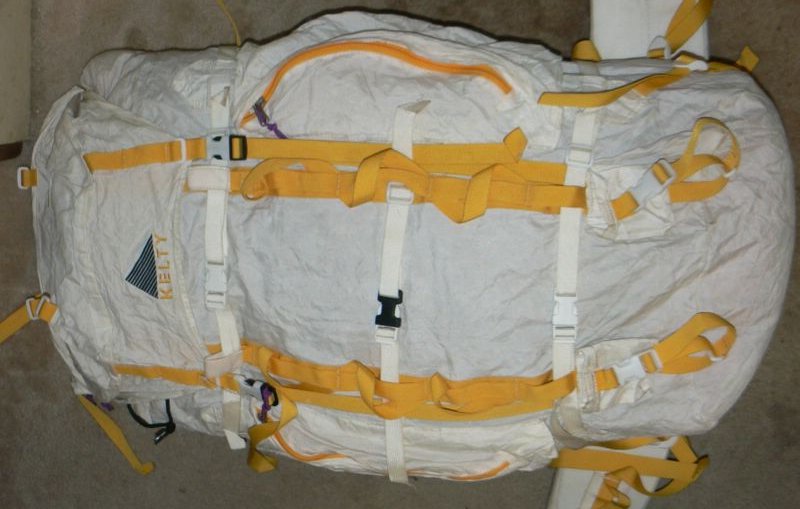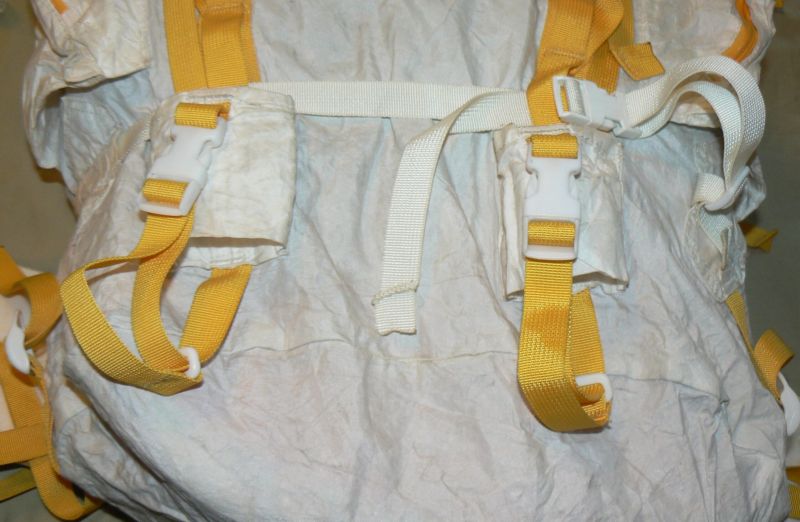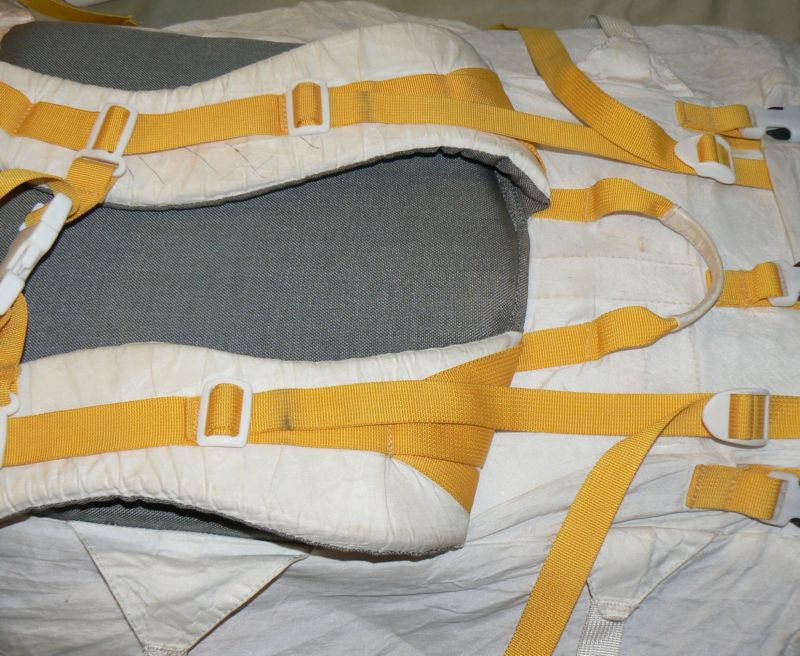See History of Kelty Spectra Backpacks for lots of information and pictures about the Kelty spectra packs. The Kelty spectra packs are likely the most durable packs ever made. All of the stitching is done with Kevlar thread (except for this very old pack), which is far stronger and abrasion resistant than nylon thread. (On my McHale spectra pack some of the stitching is in spectra, but most is in nylon.) In addition, the shoulder straps and waist strap is made with spectra fabric. Most spectra packs don't have spectra shoulder and waist straps. Most of the things sewn to the pack, such as the daisy chains and mounting points for straps are made of spectra, which I have never seen in any other line of packs. Even the internal frame parts (except the pad) are made of spectra fabric. This pack will survive a tremendous amount of abuse compared to any other pack. I believe this to be the oldest of my Kelty Spectra packs. Almost all of the trim is a bright yellow material. The 3 horizontal compression straps (which are sewn to the pack) are white material. The pack doesn't have an extension skirt at the top of the pack. This pack shows the history of a variety of design decisions that Kelty made over the years with their spectra packs. I think the new packs are more modular and I like the removable and adjustable belt of the new packs. I don't like the gear loops strewn all over the new packs, but since they can be easily removed, it isn't a big problem. Still, this pack is likely to last almost forever (except for the white nylon hardware), and is quite well made. |



Here are exterior pictures of the pack. The first picture shows the back of the pack. There are two daisy chains running up and down the pack in yellow webbing. The spiral yellow webbing is sewn into the daisy chain. No idea why. Also visible are three white compression straps that run from one side of the pack to the other. I think all of the plastic buckles for the pack started out in white plastic. Most plastic parts are black because black is the most UV resistant color, and white is likely the least UV resistant color. Also visible are two ice axe loops as well as ice axe holders made of spectra fabric. The next picture is of the front of the pack. The lid is held on with three straps with buckles. Also visible are the spectra reinforcements where the compression straps are sewn to. The padding on the front is not removable. The waist belt is not removable, nor is it adjustable. The haul strap is yellow nylon with a spectra cover over the center. The next picture is a close up of the daisy chain, showing how the spiral yellow nylon webbing is sewn in. The top of the daisy chain is reinforced with spectra fabric.


This is a close up of the ice axe holder. The shaft goes through the spectra tube and the end is secured with the yellow strap. This is a different attachment method than newer Kelty spectra packs. The next picture is the lower corner of the pack. There is a yellow compression strap. Also visible is a reinforcing patch that the main pack compression strap goes through. Also the pocket is sewn to the pack, but you can slide skis between the pocket and the body of the pack. All the other packs I have feature removable pockets.


This is the side of the pack. Visible are the three compression straps, the side pocket, the hip belt, and the bottom compression strap. The next picture is a close up of the three compression straps. There is a gap where the pocket is sewn into the pack for the central strap to slide through.

This is a side pocket. It is sewn to the pack, but there is a gap where the central compression strap passes through. Also skis can be slid between the pack body and the pocket.





This is the lid. There are four D rings on the top to secure stuff, such as a climbing helmet or crampons. There are three buckles which secure the lid the the front of the pack (against your back), and two buckles which secure the lid to the back of the pack. The lid has a single, large compartment, with a zipper to access it. There are two flaps which cover the zipper, with velcro used to secure the flaps. What is quite odd, is the flaps can be secured in two ways. Perhaps this is to keep water out when used as a top for the pack as well as when being used for a fanny pack. On the underside of the lid are two large white double D rings. The hip belt webbing can be removed, and attached to these D rings, converting the lid into a fanny pack. The buckles on the edges of the lid can be made into two compression straps for the fanny pack. The last picture shows the lid secured to the pack via three buckles.

This is a close up of the shoulder straps. All the plastic pieces are white. The black area is foam padding which is built into the front of the pack.


The hip belt has a small yellow loop near the buckle which can be used as a gear holder. The white webbing of the hip belt can be removed and used for the lid to convert it into a fanny pack. There are yellow compression straps to hold the pack close to the body. The main buckle is clear. No idea if it is the original one. The inside material of the hip belt is well padded. There is a central pad which is even thicker.


The frame is a critical part of the pack. It transfers the weight from the shoulders to the waist area. It is the backbone of the pack. The Kelty frame is made mostly of aluminum. The aluminum isn't flat stock, but rather it is corrugated to be lighter than flat stock of similar outline, and stiffer than flat stock of the same weight. Kelty calls the aluminum LightBeam, which is an appropriate name. The second picture shows the aluminum part of the frame. The first picture shows the frame which consists of a single piece of aluminum that slides into the frame. There is also a plastic sheet sewn into the frame. According to Kelty literature, there are two frame poles, plus a transverse frame piece. Not in this pack however. The second picture shows how the stay can be removed from the pack, and it is secured with yellow webbing with velcro on the end.
If you have comments or suggestions, Email me at turbo-www@weasel.com
Created with gnu emacs and template-toolkit, not some sissy HTML editor.
No Java or javascript needed to view my web pages. They
both have significant security issues.